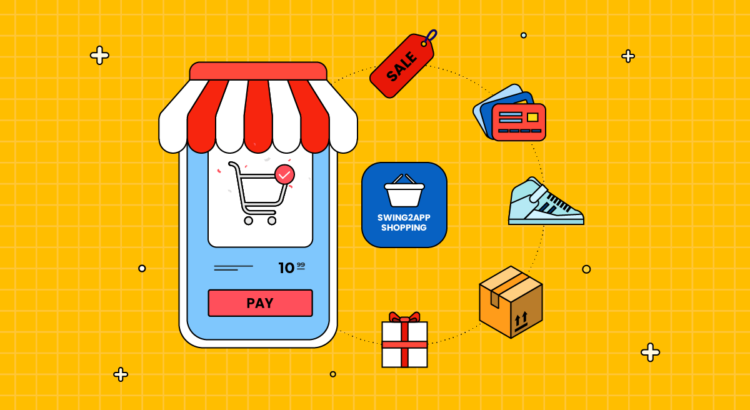In today’s digital age, e-commerce apps have become the backbone of online shopping, allowing businesses to reach global audiences and provide seamless shopping experiences. With consumers expecting convenience, security, and speed, having a well-equipped e-commerce app is crucial. Whether you’re launching a new app or enhancing an existing one, certain essential features are non-negotiable.
This write-up explores the must-have features that every e-commerce app should include to ensure a smooth user experience, boost conversions, and establish customer loyalty.
1. User-Friendly Interface and Navigation
A cluttered or confusing interface can turn away potential customers. Your e-commerce app should have an intuitive design, easy navigation, and a seamless user journey. Features such as clear category menus, search bars, and filters ensure users find products quickly. A clean UI with minimal distractions enhances usability and encourages repeat visits.
2. Fast and Secure Registration/Login Options
User registration should be simple and quick. Offering multiple sign-up options, such as email, phone number, Google, or social media login, enhances convenience. Additionally, security features like OTP verification, multi-factor authentication (MFA), and biometric login (fingerprint or face recognition) safeguard user data and enhance trust.
3. Advanced Search and Smart Filters
A robust search function is a game-changer for e-commerce apps. Features like predictive search, auto-suggestions, and voice search improve discoverability. Smart filters based on price, brand, ratings, and other attributes help customers refine their searches, ensuring they find what they need without frustration.
4. Seamless Checkout and Multiple Payment Options
A smooth checkout experience is critical in reducing cart abandonment. A well-optimized checkout process should include:
- A guest checkout option for quick purchases
- Auto-fill for address and payment details
- Multiple payment gateways, including credit/debit cards, UPI, mobile wallets, net banking, and BNPL (Buy Now, Pay Later)
- Support for international payments and digital currencies if targeting a global audience
5. Personalized Shopping Experience
Personalization increases customer engagement and conversions. AI-driven recommendation engines analyze user behavior and preferences to suggest relevant products. Features like wishlists, recently viewed items, and personalized push notifications improve user experience and encourage repeat purchases.
6. High-Resolution Product Images and Videos
Customers rely on visuals when making purchasing decisions. High-quality product images, 360-degree views, and demo videos help build confidence in the product. An AR (Augmented Reality) feature can further enhance the shopping experience by allowing users to visualize products in their space.
7. Detailed Product Descriptions and Reviews
Accurate and comprehensive product descriptions, including specifications, pricing, and usage instructions, help customers make informed decisions. User-generated reviews and ratings add credibility, influencing potential buyers. Integrating a Q&A section for each product page can also address customer queries efficiently.
8. Robust Security and Data Privacy
E-commerce apps handle sensitive data, making security a top priority. Implementing SSL encryption, secure payment gateways, and compliance with data protection regulations (such as GDPR and PCI DSS) ensures customer data remains safe. Educating users about security measures, like two-step verification, builds trust.
9. Push Notifications for Engagement
Timely notifications help keep customers engaged. Send alerts about:
- Order confirmations and shipping updates
- Discounts and flash sales
- Cart abandonment reminders
- Personalized product recommendations
However, notifications should be well-timed and relevant to avoid overwhelming users.
10. Efficient Order Management and Tracking
A well-integrated order management system ensures smooth processing from order placement to delivery. Customers should be able to track their shipments in real-time, receive estimated delivery dates, and get status updates via SMS or push notifications. Offering hassle-free order cancellations, returns, and refunds also boosts customer satisfaction.
11. Loyalty Programs and Rewards
A strong loyalty program increases customer retention. Features like cashback, referral bonuses, exclusive discounts, and reward points encourage repeat purchases. Integrating gamification elements, such as badges and achievement levels, can further boost engagement.
12. AI-Powered Chatbot and Customer Support
Providing 24/7 customer support through AI-powered chatbots improves user experience. Chatbots can handle common queries, such as order tracking, return requests, and product information. For complex issues, seamless escalation to live agents via chat, email, or phone support should be available.
13. Social Media Integration and Sharing
Social media plays a huge role in e-commerce. Allowing users to log in via social media, share products on their profiles, and read social reviews enhances brand visibility. Additionally, influencer collaborations and shoppable posts on platforms like Instagram and Facebook can drive sales.
14. Wishlist and Save for Later
Sometimes, customers may not be ready to buy immediately. The ability to save items in a wishlist or “save for later” section encourages them to return and complete the purchase. Sending reminders about wishlist price drops or limited stock availability can further drive conversions.
15. Multi-Language and Multi-Currency Support
If your e-commerce app caters to a global audience, incorporating multi-language and multi-currency support is essential. This feature enhances accessibility and provides a more personalized experience for international shoppers.
16. PWA (Progressive Web App) Capabilities
A Progressive Web App (PWA) allows users to access the e-commerce store without installing a native app. It works smoothly on mobile browsers, providing an app-like experience with offline functionality, fast loading speeds, and better performance on low-bandwidth networks.
Conclusion
A successful e-commerce app is built on a foundation of user-friendliness, security, and innovation. By incorporating these essential features, businesses can enhance customer satisfaction, drive sales, and establish a competitive edge in the market. Investing in a feature-rich e-commerce app is not just an option but a necessity in today’s fast-evolving digital landscape.
For more insights on e-commerce solutions, digital marketing, and technology trends, stay tuned to Razorse Digital Solutions. Let’s build the future of e-commerce together!
